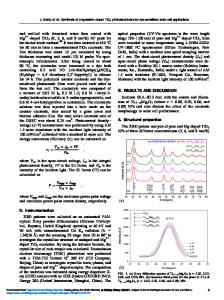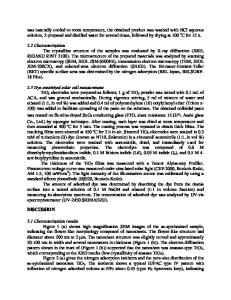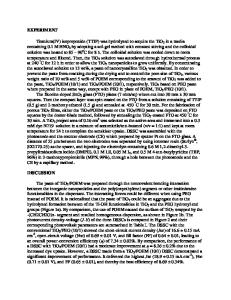Mesoporous nitrogen-doped TiO 2 sphere applied for quasi-solid-state dye-sensitized solar cell
- PDF / 879,323 Bytes
- 5 Pages / 595.28 x 793.7 pts Page_size
- 87 Downloads / 297 Views
NANO EXPRESS
Open Access
Mesoporous nitrogen-doped TiO2 sphere applied for quasi-solid-state dye-sensitized solar cell Peng Xiang, Xiong Li, Heng Wang, Guanghui Liu, Ting Shu, Ziming Zhou, Zhiliang Ku, Yaoguang Rong, Mi Xu, Linfeng Liu, Min Hu, Ying Yang, Wei Chen, Tongfa Liu, Meili Zhang and Hongwei Han*
Abstract A mesoscopic nitrogen-doped TiO2 sphere has been developed for a quasi-solid-state dye-sensitized solar cell [DSSC]. Compared with the undoped TiO2 sphere, the quasi-solid-state DSSC based on the nitrogen-doped TiO2 sphere shows more excellent photovoltaic performance. The photoelectrochemistry of electrodes based on nitrogen-doped and undoped TiO2 spheres was characterized with Mott-Schottky analysis, intensity modulated photocurrent spectroscopy, and electrochemical impedance spectroscopy, which indicated that both the quasiFermi level and the charge transport of the photoelectrode were improved after being doped with nitrogen. As a result, a photoelectric conversion efficiency of 6.01% was obtained for the quasi-solid-state DSSC. Introduction Since a mesoscopic TiO2-based dye-sensitized solar cell [DSSC] was reported by O’ Regan and Grätzel in 1991 [1], DSSC has emerged as a promising candidate for the practical photovoltaic application due to its low manufacturing cost and high energy conversion efficiency. Even though DSSC is now commercially available, market expansion is still limited because of the use of a liquid electrolyte, which always signifies instability due to the leakage of the solvent and the erosion of the electrode. It seems a good way to replace the liquid electrolyte by a solid-state or quasi-solid-state medium [2,3]. Unfortunately, compared with liquid electrolyte, solidstate or quasi-solid-state DSSC still presents lower energy conversion efficiency. Therefore, how to improve the performance of DSSC composing of solid-state or quasi-solid-state medium is still a big issue. As one of the key components, mesoscopic TiO2 film plays an important role in determining the performance of DSSC, which assumes both the task of dye anchorage and charge carrier transport. Over the past decade, substantial efforts have been made to improve the performance of DSSC through the reformation of the TiO 2 film. The first strategy is to increase the light absorption efficiency of the photoanode by increasing the surface * Correspondence: [email protected] Michael Grätzel Center for Mesoscopic Solar Cells, Wuhan National Laboratory for Optoelectronics, Huazhong University of Science and Technology, Wuhan, 430074, Hubei, People’s Republic of China
area of the TiO2 film, which provides sufficient room for dye loading. Another strategy is to improve the electron injection efficiency by adjusting the conduction band edge to match the LUMO of the dye [4]. The last strategy is to increase the charge collection efficiency through the improvement of the electron transport or lifetime [5]. For an effective DSSC, the key parameters of the mesoscopic TiO2 film such as porosity, pore size distributio
Data Loading...











